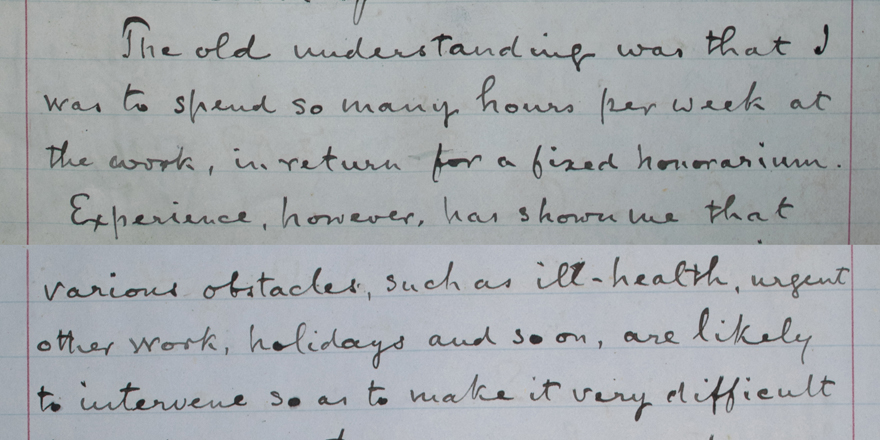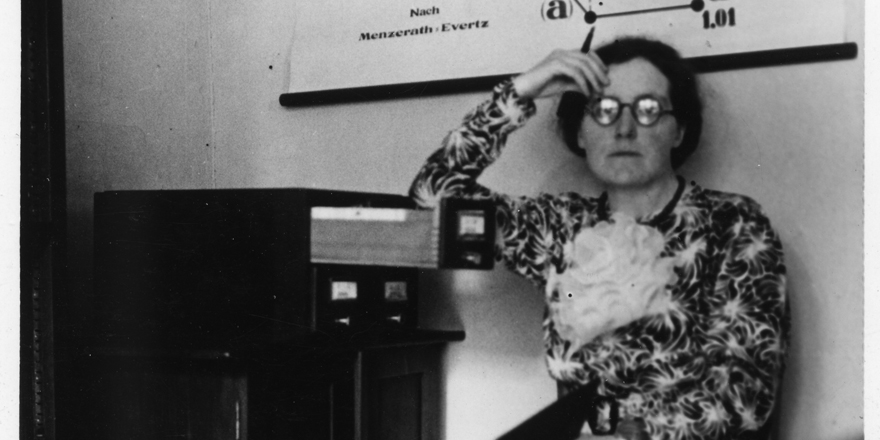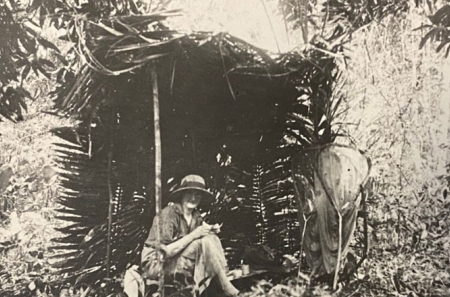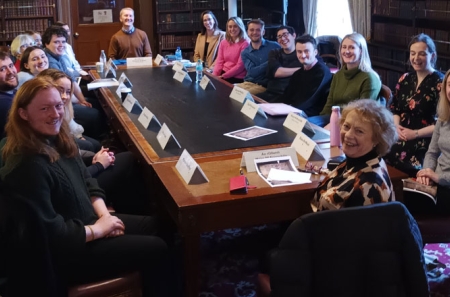
The Catalogue of Irish manuscripts in the Royal Irish Academy – an unfinished story
31 May 2021Latest Library Blog post. Dr Bernadette Cunningham looks at the development of the Catalogue of Irish manuscripts in the Royal Irish Academy.
In the years before and after the formation of the Irish Free State, there was a flurry of scholarly activity in the preparation of new catalogues of manuscripts in the Irish language held in archives at home and abroad. Archivists and cataloguers like to believe their work is not influenced by political agendas, but was it mere coincidence that work was simultaneously underway in Dublin and London one hundred years ago on the production of a range of scholarly catalogues of Irish manuscripts? It was a time when nation-building and the cultivation of the academic study of the Irish language went hand in hand. Academy Members took a leading role. In the early decades of the twentieth century the Royal Irish Academy’s Irish Manuscripts Committee (later renamed the Irish Studies Committee) coordinated some major research projects, chief among them being the Academy’s Catalogue of Irish Manuscripts, the Dictionary of the Irish Language (dil.ie), and the short-term Doegen dialects project (Doegen.ie).
c. 1920-1943
Just as the new Irish state was coming into being, work got underway at the Royal Irish Academy in Dublin to compile and publish in-depth descriptive catalogue entries for each of the approximately 1,400 Irish language manuscripts in the Academy library. This was designed to supersede all previous and partial unpublished catalogues of the collection compiled at various times since the early 1840s. Given the scale of the task of comprehensively cataloguing what is believed to be the world’s largest collection of manuscripts in the Irish language, the speed of the new project was impressive. Twenty-seven fascicules of the Academy Catalogue of Irish manuscripts were written and published between 1926 and 1943.
Meanwhile, a one-volume Catalogue of the Irish manuscripts in the Library of Trinity College Dublin, largely compiled by college librarian Thomas K. Abbott before his death in 1913 and completed by Edward J. Gwynn, MRIA, was published in Dublin and London in 1921.
Five years later, a two-volume Catalogue of Irish manuscripts in the British Museum was published in London. Of the two volumes issued in 1926, the first had been drafted berween 1886 and 1892 by Standish Hayes O’Grady, the second was the work of Robin Flower, who had been employed at the Museum since 1906. Many years later, in 1953, a third volume was published, comprising a wide-ranging general introduction and an index. This final volume, with its detailed introduction to the British Museum (now British Library) collection of Irish manuscripts, was also the work of Robin Flower. Seven years after his death, it was seen through the press by Myles Dillon, MRIA.
At St Patrick’s College, Maynooth, Rev. Paul Walsh, MRIA, initiated work on a catalogue of the Irish manuscript collections there. One fascicule was published in 1927 but the task was unfinished at his early death in 1941. Two decades later Rev. Pádraig Ó Fiannachta, MRIA, took up the challenge and completed the project, in a different style, adhering more closely to the format of the RIA catalogues. Ó Fiannachta opted to write his catalogue entries in Irish rather than English.

The Royal Irish Academy had the largest collection of Irish manuscripts and the importance of publishing scholarly catalogues of the Academy collection was recognised. The Academy’s Manuscripts Committee which undertook to oversee the project was steered by Osborn Bergin, MRIA, and Richard I. Best, MRIA. Under its auspices it was first agreed that Thomas F. O’Rahilly, MRIA, of Trinity College Dublin, would work as a cataloguer of manuscripts for a fixed number of hours per week in return for an honorarium. By early 1922, however, O’Rahilly realised that ‘ill-health, urgent other work, holidays and so on’ prevented him working to the kind of fixed schedule such an arrangement demanded (RIA, Minutes of Irish MSS Committee, 12 Apr 1922). His alternative proposal of working irregularly on the project as time permitted, without any honorarium, was accepted. The first fascicule, in which 54 of the Academy’s manuscripts were described, was published in the spring of 1926.

RIA, Minutes of Irish MSS Committee, 12 Apr 1922
The Academy’s Manuscripts Committee then sought additional cataloguers with a view to expediting the next phase of the project. They looked first to three women, Mary E. Byrne, Maud Joynt and Eleanor Knott, who were already working on another large-scale Academy project, the Dictionary of the Irish Language. These three lexicographers were asked to undertake cataloguing of manuscripts without reducing the time they devoted to the Dictionary. Of the three, only Mary E. Byrne agreed to become involved with the Catalogue, dividing her time between the two projects (10 hours a week on each project). Her catalogue descriptions of 47 Irish manuscripts were published in 1928 as fascicule 3.
Kathleen Mulchrone, a graduate of University College Dublin and a former student of Rudolf Thurneysen in Bonn, began work on the Catalogue of Irish manuscripts in the early months of 1927. Her first fascicule was published in 1928. Kathleen Mulchrone’s involvement with the project proved crucial and she continued in the post until 1938. She contributed more than any other scholar, writing not just routine catalogue descriptions of relatively minor manuscripts but also contributing detailed descriptions of the contents of major medieval manuscripts such as the Book of Lecan (catalogue entry 535) and the Book of Ballymote (catalogue entry 536) in fascicule 13.
Steady progress was maintained on the Catalogue until completion, with a total of eight cataloguers working on the project at various times between 1921 and 1943. Kathleen Mulchrone produced eight fascicules and was joint author of four more; Elizabeth FitzPatrick completed six fascicules and was joint author of two more; Lilian Duncan wrote two fascicules; Gerard Murphy, MRIA, wrote fascicule 11 and part of fascicule 18; Winifred Wulff was a joint author of fascicules 10 and 18; Mary E. Byrne and T. F. O’Rahilly each wrote one fascicule; James Delargy, MRIA, was co-author of one fascicule. (Notice that the men were all elected as Members of the RIA; none of the women were!)

Kathleen Mulchrone
In all, the project as originally devised resulted in the publication of 27 fascicules, the last of them published in 1943. Two index volumes followed in 1948 and 1958. The indexes were compiled by Kathleen Mulchrone and Elizabeth FitzPatrick. They were assisted by Nancy Pearson who also worked on the Dictionary project.
These indexes were essential to the usefulness of the entire work, particularly since each fascicule of the published catalogue dealt with a selection of manuscripts in random order, taking no account of date, provenance, subject category, or shelf-mark. That randomness was deliberate. T.F. O’Rahilly explained in a note printed on the inside covers of the first fascicule that his intention had been ‘to make such a selection as would illustrate the varied character of the MSS written in Irish between 1600 and 1850’. He also set the precedent for following manuscript orthography in quotations, and for using a ‘slightly modified form of early modern Irish orthography’ in personal names, but ‘a rigid uniformity has not been aimed at’ (O’Rahilly, 1926).
1970-2000
A twenty-eighth fascicule, cataloguing a further 69 manuscripts acquired by the Academy between the early 1940s and 1970, was prepared by Tomás Ó Concheanainn, MRIA, and published in 1970. This later fascicule has its own index – researchers need to remember to consult it if the manuscript they seek is not described in the earlier fascicules.
The publication of the Catalogue of Irish manuscripts in the Royal Irish Academy was followed by the microfilming of the entire collection in the 1980s in association with University College Cork. The sale of the microfilm series to research libraries ensured that the collection was truly accessible to a wide range of scholars for the first time, without the need to visit the Academy library in person on each occasion. In the two decades since 2001, almost 100 older manuscripts from the Academy collections have been digitised in association with the Irish Script on Screen (ISOS) project of the School of Celtic Studies, Dublin Institute for Advanced Studies. These are freely available online on an open access basis. The digitisation of more RIA manuscripts in association with ISOS is planned.
The catalogue descriptions that accompany the ISOS images are essentially the descriptions first published in print between 1926 and 1970. Good quality metadata does not just appear by magic! The catalogue entries prepared almost 100 years ago are a crucial element of the digital project.
The published catalogue descriptions of Academy manuscripts became so influential in the second half of the twentieth century that some researchers began citing Academy manuscripts by the catalogue entry number instead of the shelf-mark needed to find and consult the original manuscript. Indeed, the descriptions were so comprehensive that in some circumstances it was unnecessary to consult the item itself. For the sake of clarity and consistency in academic publications, it became necessary to issue a guide to how to cite Academy manuscripts.
Researchers consulting original Irish manuscripts in the Academy library continue to make extensive use of the printed catalogues. Such is the demand that there are multiple sets available for daily use in the Library Reading Room. One of those sets is interleaved (RR/Ref 2/C), and library staff have annotated it (sparingly) down through the decades, noting incidental new information such as the rebinding of an item. Nowadays such updates are entered on the online catalogue instead.
Online and in print
Since 2001 the Academy library’s online catalogue of manuscripts has included an inventory of the Irish language manuscripts in summary form. The online database contains more details on the provenance of collections than was provided in the printed catalogue, but is not yet complete in that regard. It also provides details of microfilm numbers, photostats, and digital editions. Cross references to the relevant pages of the printed catalogues, as well as to two earlier series of unpublished catalogues of selected manuscripts, are also provided. The online catalogue is not, however, a replacement for the printed Catalogue of Irish manuscripts and the two very different types of catalogue are best used together. Nor would it be appropriate for the current online catalogue simply to absorb the content of the printed catalogues without any updating, and that has not been done. The printed catalogues are a product of their era and need to be used and understood as such. They should be digitised as originally published and made available on open access online.
During the COVID-19 pandemic lockdown in 2020-21, the absence of a digitised set of the Academy’s Catalogue of Irish manuscripts (and indeed of the similar published catalogues of other collections of Irish language manuscripts in other archives) was a stumbling block for researchers. RIA Library staff were regularly asked to provide images of selected pages from those printed catalogues to researchers locked out of libraries.
There is no doubt that these printed catalogues are still an essential reference resource, even if some details of the descriptive entries are now somewhat dated. For obvious reasons they do not record changes since the 1920s such as the rebinding of some items – for example MS 23 P 10 is now bound as three volumes and the arrangement of its vellum leaves was revised prior to rebinding. In other instances, recent scholarship has made information available that was not known to the early twentieth-century cataloguers. Understandably, those cataloguers were more interested in texts than in contexts and they devoted little attention to the provenance of individual manuscripts or collections.
A projected ‘General Introduction’ to the Catalogue of Irish manuscripts was frequently mentioned in the General Index (1958) but was never written. It was evidently envisaged by Kathleen Mulchrone and her colleagues that this would provide an account of the history of the various individual collections that comprised the Academy holdings of Irish manuscripts, and that it would contain detailed information on provenance and acquisition of specific collections. In the event, just a ‘short introduction’ compiled by Elizabeth FitzPatrick was issued in 1988. The booklet was dedicated to Kathleen Mulchrone, who had died in 1973. It was subsequently updated by Academy Librarian Siobhán Fitzpatrick, and made available online, but the story of how the Academy’s collection of Irish manuscripts was assembled, and from whom items were acquired, has only been partially told.
Limitations
In normal times, Academy Library staff responding to queries about the collections have the luxury of being able to consult the original manuscripts whenever necessary. Queries continued to arrive through the pandemic-related lockdowns in 2020 and 2021, but library staff were reliant solely on the catalogues rather than the manuscripts themselves.
Some shortcomings in catalogue coverage were noticed. One difficulty arose regarding manuscripts with content partly in Irish and partly in English. In most instances, only the Irish language content was fully described in the printed catalogue. And, since the online catalogue of manuscripts is derived in part from the printed catalogues in respect of those same manuscripts, there were puzzles that could only be solved by an in-person visit to the library.
The presence of antiquarian notes in English in a nineteenth-century County Louth literary manuscript in Irish could not be verified until it was possible to consult the original item. The presence or absence of some translations into English of Irish poems could not be confirmed by reference to the catalogue alone. In its exclusive focus on Irish language content, the printed Catalogue of Irish manuscripts disguises the extent of dual language manuscripts in the collection, and that is an issue that remains to be addressed. Indeed, those dual language manuscripts contain source material for a great research topic on the progress of bilingualism.
Additions, 2020-21
Aspects of the broader question of the provenance of the Academy’s collection of Irish language manuscripts, medieval and modern, helped keep this present blogger gainfully occupied during pandemic lockdowns in 2020 and early 2021, while most regular library work was suspended. The ‘special collections’ pages of the Library website now contain many new essays on highlights of the Academy’s archival collections. These include short essays on major Irish language manuscript collections acquired during the nineteenth century. Among the more significant purchases, donations and bequests of mostly modern manuscript collections for which new information is now available on the Library website are those acquired from Hodges and Smith (1844), Sir William Betham, MRIA (1851), William Elliott Hudson, MRIA (1853), John O’Daly, MRIA (1869), and William Smith O’Brien, MRIA (1871).
The special collections pages on the Library website, through descriptions of whole collections as well as of individual manuscript highlights, are being developed as contributions towards a more comprehensive introduction to the Irish language manuscript collections in the RIA.
The work of librarians and archivists can never be regarded as complete, however, and there are recent additions to the Academy collections, including the Irish language manuscripts acquired by purchase or donation since 1970, that still await the full attention that they deserve.
Bernadette Cunningham
Deputy Librarian
May 2021
LIST
Catalogue of Irish manuscripts in the Royal Irish Academy (28 fasc., Dublin, Royal Irish Academy; Hodges, Figgis & Co.; London: Williams & Norgate: 1926–70)
Volume 1 (1926–30)
Fasciculus I: Catalogue entries 1–54 / Thomas F. O’Rahilly
Fasciculus II: Catalogue entries 55–89 / Kathleen Mulchrone
Fasciculus III: Catalogue entries 90–136 / Mary E. Byrne
Fasciculus IV: Catalogue entries 137–195 / Kathleen Mulchrone
Fasciculus V: Catalogue entries 196–252 / James H. Delargy & Kathleen Mulchrone
Volume 2 (1931–3)
Fasciculus VI: Catalogue entries 253–279 / Kathleen Mulchrone
Fasciculus VII: Catalogue entries 280–328 / Kathleen Mulchrone & Elizabeth FitzPatrick
Fasciculus VIII: Catalogue entries 329–379 / Lilian Duncan
Fasciculus IX: Catalogue entries 379–438 / Elizabeth FitzPatrick
Fasciculus X: Catalogue entries 439–483 / Winifred Wulff & Kathleen Mulchrone
Volume 3 (1933–5)
Fasciculus XI: Catalogue entries 484–493 / Gerard Murphy
Fasciculus XII: Catalogue entries 494–534 / Elizabeth FitzPatrick
Fasciculus XIII: Catalogue entries 535–540 / Kathleen Mulchrone
Fasciculus XIV: Catalogue entries 541–581 / Elizabeth FitzPatrick
Fasciculus XV: Catalogue entries 582–616 / Elizabeth FitzPatrick
Volume 4 (1935–6)
Fasciculus XVI: Catalogue entries 617–671 / Kathleen Mulchrone
Fasciculus XVII: Catalogue entries 672–725 / Lilian Duncan
Fasciculus XVIII: Catalogue entries 726–754 / Gerard Murphy & Winifred Wulff
Fasciculus XIX: Catalogue entries 755–776 / Kathleen Mulchrone
Fasciculus XX: Catalogue entries 777–859 / Kathleen Mulchrone
Volume 5 (1936–40)
Fasciculus XXI: Catalogue entries 860–938 / Elizabeth FitzPatrick
Fasciculus XXII: Catalogue entries 939–993 / Kathleen Mulchrone
Fasciculus XXIII: Catalogue entries 994–1059 / Elizabeth FitzPatrick & Kathleen Mulchrone
Fasciculus XXIV: Catalogue entries 1060–1133 / Elizabeth FitzPatrick
Fasciculus XXV: Catalogue entries 1134–1191 / Gerard Murphy & Elizabeth FitzPatrick
Volume 6 (1942–3)
Fasciculus XXVI: Catalogue entries 1192–1225 / Kathleen Mulchrone
Fasciculus XXVII: Catalogue entries 1226–1361 / Kathleen Mulchrone & Elizabeth FitzPatrick (1970)
Fasciculus XXVIII: Catalogue entries 1362–1461 / Tomás Ó Concheanainn
Index volumes
Index I: First lines of verse (to Fasc. I–XXVII) by Kathleen Mulchrone and Elizabeth FitzPatrick, assisted by A.I. Pearson (Dublin, 1948)
Index II: General (to Fasc. I–XXVII) by Kathleen Mulchrone, assisted by Elizabeth FitzPatrick and A.I. Pearson (Dublin, 1958)
Index to Fasc. XXVIII is published as part of Fasc. XXVIII by Tomás Ó Concheannain
Complete sets of the printed Catalogue of Irish manuscripts in the Royal Irish Academy are still available for sale through the School of Celtic Studies, Dublin Institute of Advanced Studies. DIAS Shop – #DIASdiscovers
Further reading
Royal Irish Academy, Minutes of the Irish Studies Committee, IV (1922-52) (SR/16/B)
Abbott, T.K. & Gwynn, E.J., Catalogue of Irish manuscripts in the Library of Trinity College Dublin (Dublin, 1921)
FitzPatrick, Elizabeth, catalogue-of-irish-mss-in-the-ria-a-brief-introduction-revised-2003.pdf
O’Grady, S.H. and Flower, Robin, Catalogue of Irish manuscripts in the British Museum (3 vols, London, 1926-53)
Walsh, Paul & Ó Fiannachta, Pádraig. Lámhscríbhinní Gaeilge Choláiste Phádraig Má Nuad (7 fascicles, Maynooth, [1927]; 1943-72)
Guidelines for citing Royal Irish Academy manuscripts
Irish Script On Screen - Meamram Páipéar Ríomhaire (dias.ie)
Modern Manuscripts | Royal Irish Academy (ria.ie)


